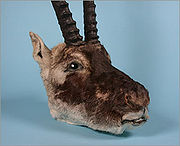Animals of Tibet's Chang Tang
The wildlife on the upper roof of the world.
Chiru

Tibetan antelope or Chiru (Pantholops hodgsonii) (Chinese 藏羚羊) – the sole species in the genus Pantholops, is a medium-sized bovid which is about 80cm (2 foot 7 inches) in height at the shouder. It is native to the Tibetan plateau including China'sTibet Autonomous Region, Qinghai province, and Xinjiang province; India near Ladakh, formerly western Nepal. The Tibetan antelope is also known commonly by its Tibetan name Chiru. The coat is grey to reddish-brown, with a white underside. The males have long, curved-back horns which measure about 50 cm (20 inches) in length. There are less than 75,000 individuals left in the wild, down from a million 50 years ago.
It was formerly classified in the Antilopinae subfamily, but morphological and molecular evidence led to separation of the Chiru in the monotypic Pantholopinae, closely allied to goat-antelopes of the subfamily Caprinae (Gentry 1992, Gatesy et al. 1992, Ginsberg et al. 1999).
Tibetan antelope are gregarious, sometimes congregating in herds hundreds strong. The females migrate up to 300 km yearly to calving grounds in the summer where they usually give birth to a single calf, and rejoin the males at the wintering grounds in late autumn (Schaller 1998). Chirus live on the high mountain steppes and semi-desert areas of the Tibetan plateau such as Kekexili, where they feed on various forb and grass species. The average life span is about eight years.